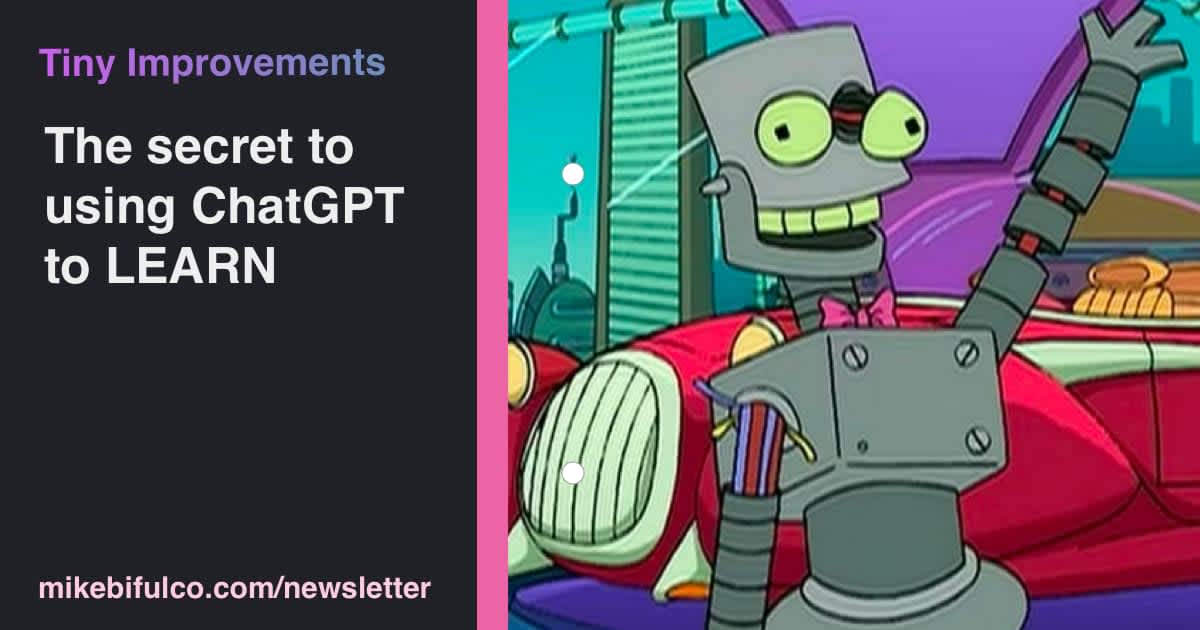- Home
- Newsletter
- An idiot's guide to using ChatGPT to make yourself smarter
An idiot's guide to using ChatGPT to make yourself smarter

AI is everywhere.
Chat GPT and interfaces like it have found themselves centerstage in tech culture. AI features have been added to search engines, word proccesing tools, image editors, audio editing software, and for crying out loud, even Snapchat! It's an exciting time, and there's lots to learn from the new frontier of AI-powered tools -- especially, I think, for people who don't work in heavily technical roles.
I've been writing about generative AI for a while ("Hey Influencers, be careful with ChatGPT") - and I'm really happy to see that it's finally starting to find its way into the mainstream. It's super interesting to see all of the creative ways that people are using it. Seeing people find ways to use ChatGPT through the lens of their own experiences, skills, and desires is truly fascinating.
Today, I want to talk about using tools like ChatGPT to learn.

Hiring developers made easy:
- ✅ Search in 24,000+ remote developer profiles
- ✅ All developers have passed our extensive screening
- ✅ See their salary expectations upfront in their profiles
Do you want to try our Hiring Platform for free?
One of the most common use cases I've seen for people using ChatGPT for the first time is - "tell me about %some-interesting-thing%". ChatGPT can distill complex topics into easily understandable summaries in a flash. It's thrilling -- seriously. But there's a tradeoff: ChatGPT's speed to respond can make it feel like we never need to think again. Got a question? Ask the robots. Curious about something? Ask the robots. Can't remember that one thing from high school physics? Ask the robots.
Offloading work from your brain is a good thing -- but making knowledge fully disposable isn't. Retaining some of the things we learn is what helps us draw connections, foster creativity, and grow as people.
The Generation Effect is the idea that you'll remember and understand stuff better when you put in the effort to do it yourself, rather than passively taking it in.
The thing is, when we take the time to experience and write about something, we're not just passively absorbing information. We're actively making connections, thinking critically, and making the material our own. It's the difference between watching a tutorial on YouTube about fixing your dryer, and then actually fixing the damn thing yourself. Applied experience will do a lot more to cement learnings in your brainmeat™️.
When we engage with the material, we're more likely to remember it.

This is where tools like ChatGPT come in. These AI-powered dudes can be super helpful in getting our creative juices flowing. They can toss ideas back and forth with us, ask questions, and give us inspiration. By ChatGPT to kickstart our thinking, we're more likely to dive deep into a subject and learn more than if we were just scrolling through generated content on our own. That's a win.
So, the bottom line is that by getting hands-on and generating our own ideas, we stand to learn and retain so much more than if we're just skimming through content. And when we use ChatGPT to help us, we're taking advantage of the best of both worlds: the AI's ability to spark ideas and our own creative thinking to really make that knowledge stick.
For me, that means using AI tools to generate high-level bullets, and doing the work of expanding on those points and summarizing myself. When I'm doing research, the initial high-level points for my notes may start from ChatGPT,but in the process of summarizing, they often get revised to a completely different set based on my perspective. It's often enough to cause me to ask the bots for more specific summaries, or a pivot from one topic to another.
For example -- this very newsletter started out as 5 bullets from chatGPT about something called the Doorway Effect.
The simple act of going a level deeper to engage with the things generates can be surprisingly productive. Give it a shot the next time you fire up ChatGPT - you might be surprised by the things you learn.
Tucked away in my notes about taking notes
- 🗂️ The Tickler File System is a physical system for organizing tasks that need to be completed on specific dates. It pre-dates digital note-taking, but is certainly a forebearer of more modern systems like Getting Things Done. It's a surprisingly elegant system - 43 folders are used to represent tasks for each day of the year. I know -- I was surprised, too.
- 🎥 My brilliant better-half Natalie recently released a video about ChatGPT in K-12 schools on her YouTube channel, Primary Focus. The big idea: it's time to lean in to AI for education, and not build walls around it. The revolution is here, my dudes.
- 🧘♂️ Axios published a great article on Using ChatGPT for therapy. Therapy is a good thing, and many people can't afford it. Chatbots are not a perfect solution by any means, but if they can help expand access to healthcare, that's got to be a good thing.
Cache me outside
- 🎙️ My interview with Guillermo Rauch from Vercel for Software Engineering Daily went live last week. Guillermo is clearly an extremely thoughtful and clever leader -- and I was lucky to get some time with him to talk shop.
- 🎤 I also interviewed YC Founder Danny Sheridan about his new startup, Fern. If you're building SDKs or client libraries for your company's API, you'll appreciate this one.
- 📖 As I've been prepping outlines for a quick course on note-taking, I was reminded that I've shared some of my notery on my site before. My article Book Notes: Working in Public is essentially a direct copy/paste of my notes on a great book from Nadia Eghbal called Working in Public: The Making and Maintenance of Open Source Software.




